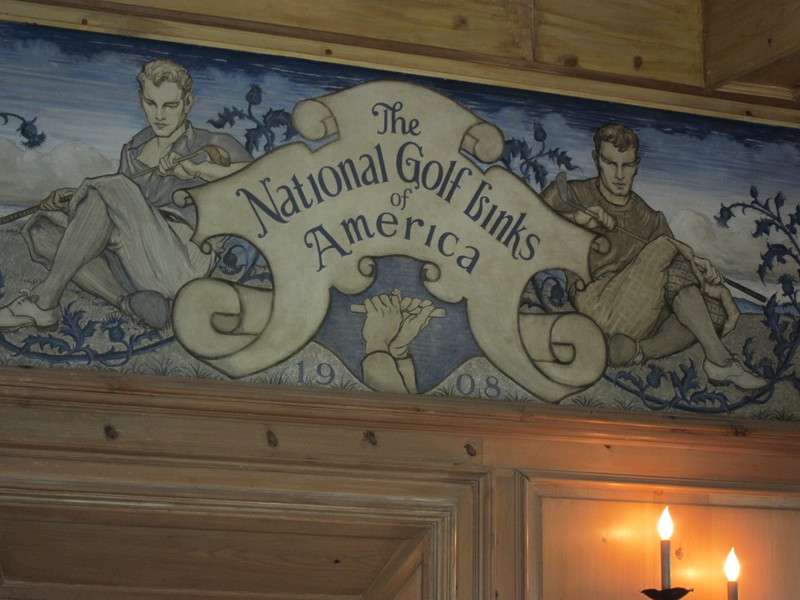
A week has passed since National Golf Links of America and I spent a wonderful day together and I've only really stopped thinking of her for a few minutes at a time since. The most common words out of my mouth the final week of my holiday with my wife were a distracted "I'm sorry, what were you saying?".
This tour won't go nearly as in-depth as Pat Mucci's wonderful
Enchanted Journey series (one play vs dozens [hundreds?], so how could it?) -- but I can promise you that it will move at a faster pace!
The golf course is as packed with thrilling and fun shots as anything I have played, is home to maybe the best set of greens I've seen, is built on fantastic land for golf in a beautiful location, is playable for any standard of golfer and is far from a pushover despite modest length.
That is a remarkable list of attributes and I hope my photos and commentary will show all those factors.
Likewise, where criticism of the MacRaynor style often includes the words "unnatural" and "engineered", I hope this might also illustrate that the two need not be mutually exclusive.
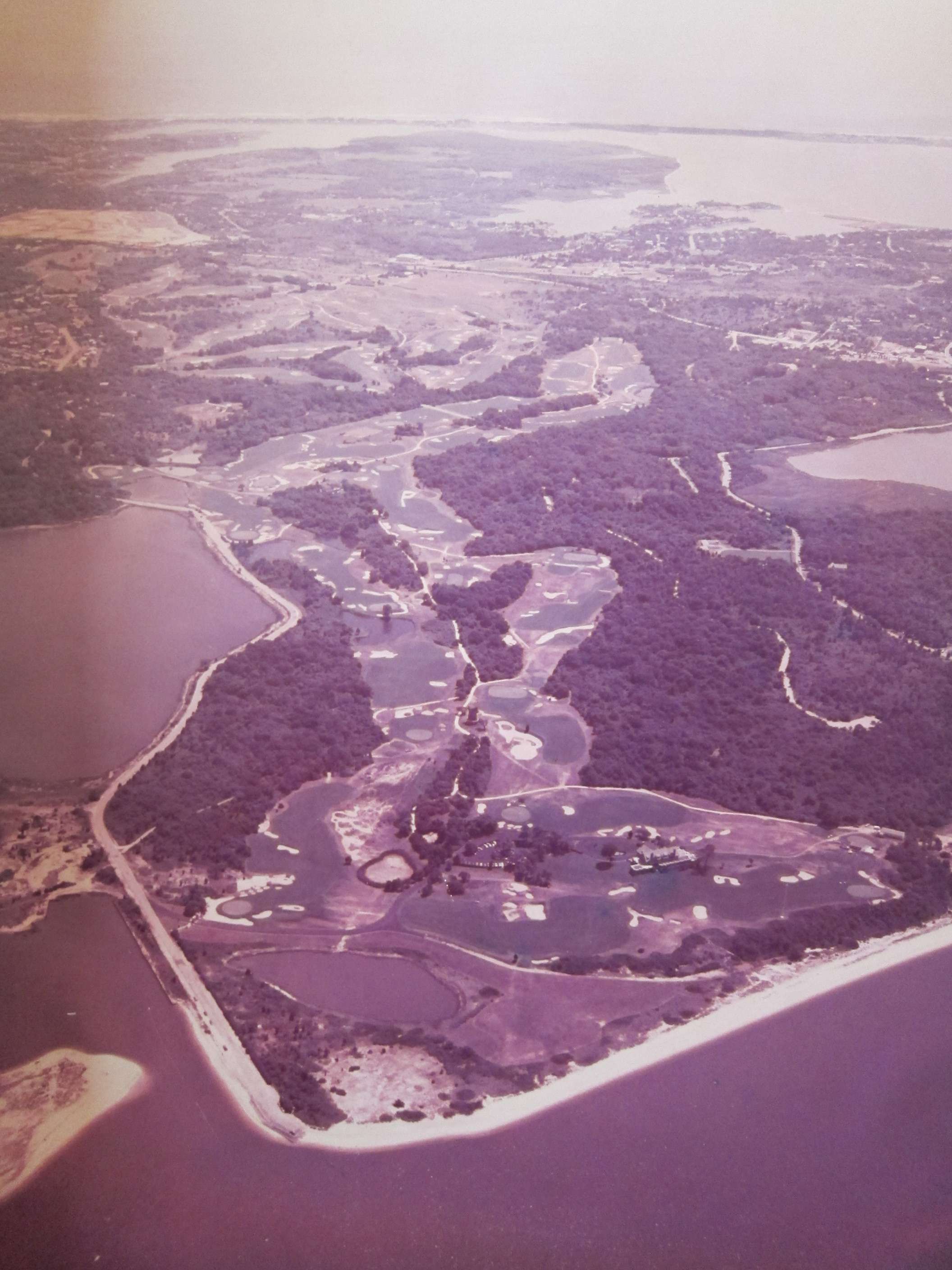
The routing: The course begins in the bottom right of the above picture and heads towards the top of the frame, staying on the right of the course, before the back nine begins at the middle of the picture and snakes its way back to the 18th, seen sitting beside the water at the bottom.
Significant changes of direction come at the 2nd, 4th, 5th, 6th, 7th, 9th, 10th, 11th, 13th, 14th and 18th -- showing once more that an out and back routing needn't mean that the wind will be hitting you from the same predictable directions all day.
At the top centre-left of the picture is Shinnecock Hills and Sebonack now occupies the wooded area on the right.
1st - Valley - 315 yards All yardages from the green "regular" tees, which measure 6505 yards. The "championship" course is 6935 yards and the "short" course is 5771 yards. From all three tees the course plays to a par of 72.The opening drive may be the most unnerving on the course. It looks more narrow than it plays, but at such a modest length an iron is a definite option. The temptation is to drive down the left to avoid a blind second over the centre-right fairway bunker to maybe the most complex, wild green on the course, though that requires a longer carry over rough and blind bunkers. The yardage screams "birdie", but there can't be too many golfers who are disappointed to write down "4" as they walk to the 2nd tee.

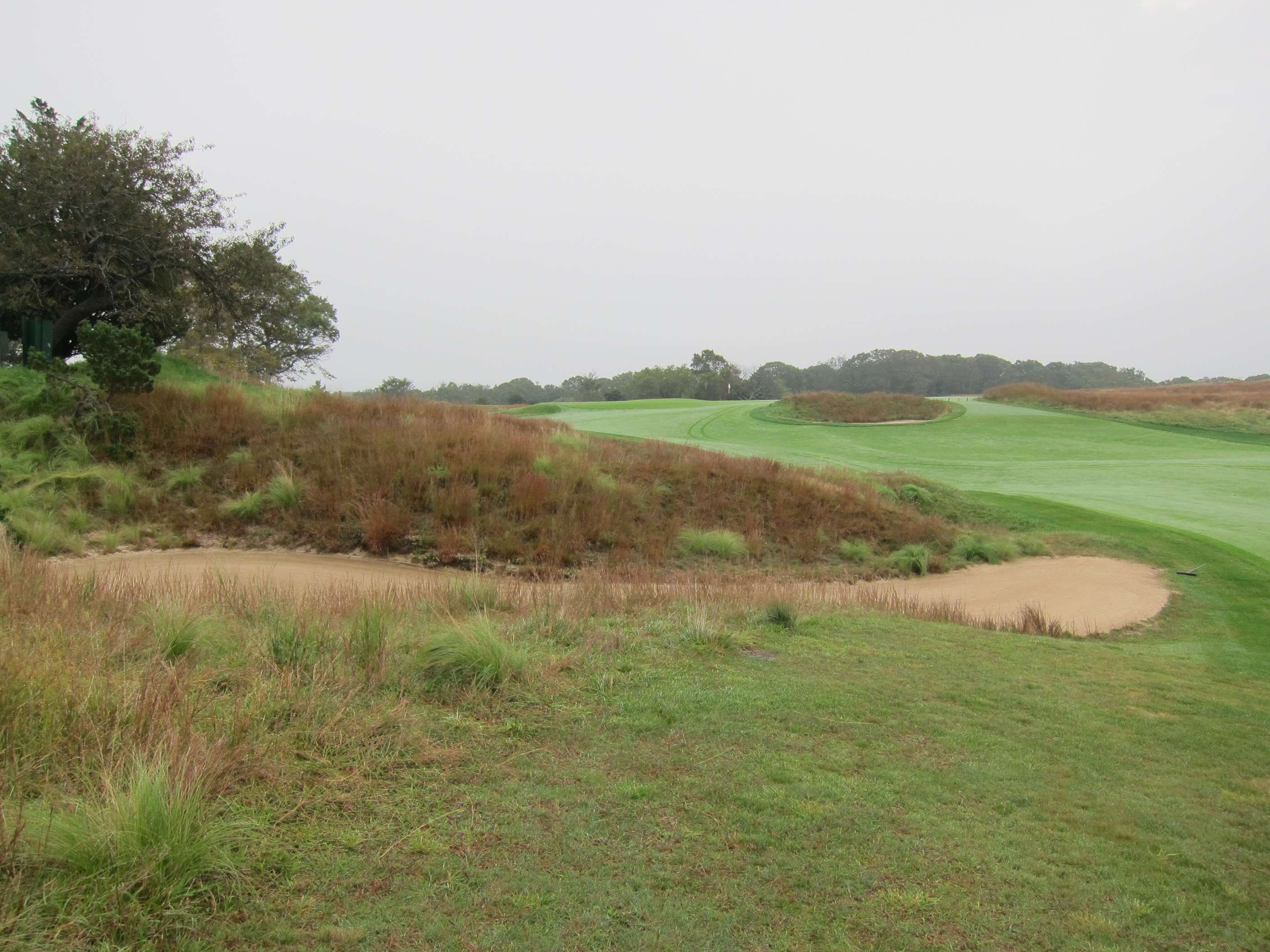 2nd - Sahara - 290 yards
2nd - Sahara - 290 yardsThe first of several blind drives, with but ample room right for a safer tee shot. The green can be reached, but doing so requires a brave line roughly half-way between the sand and windmill in the picture below. Those trying their luck at reaching the green can't afford to err to the right, where the fairway falls away dramatically, feeding the ball towards rough, or at best an uphill half wedge from a sidehill lie to a slightly domed green that's largely sloping away from you! As with many holes to come, your potential for distance is only as good as your likelihood of successfully executing the shot, because while there are great benefits for bravery at NGLA, there is also tremendous punishment for a misguided display of brawn.
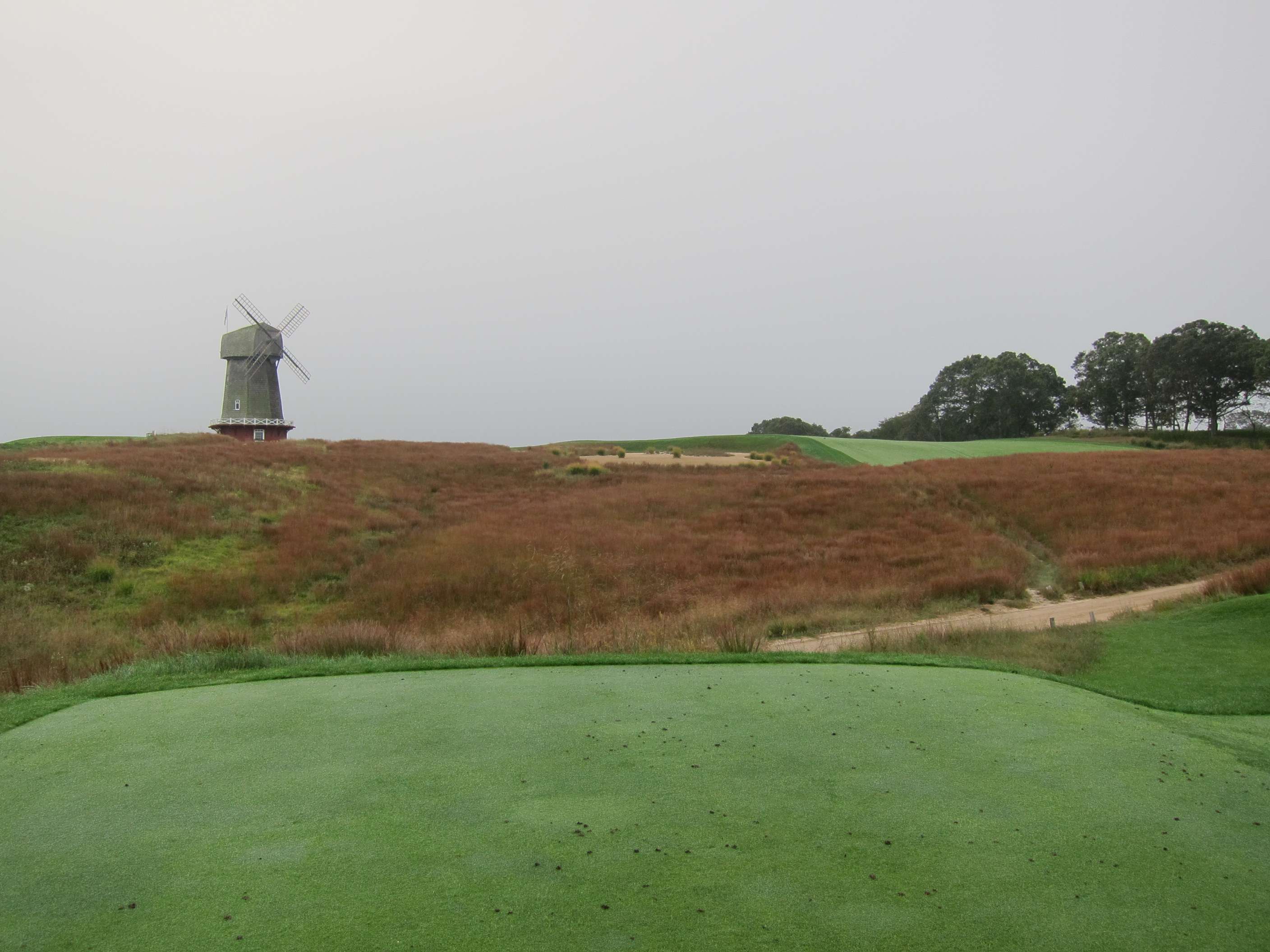
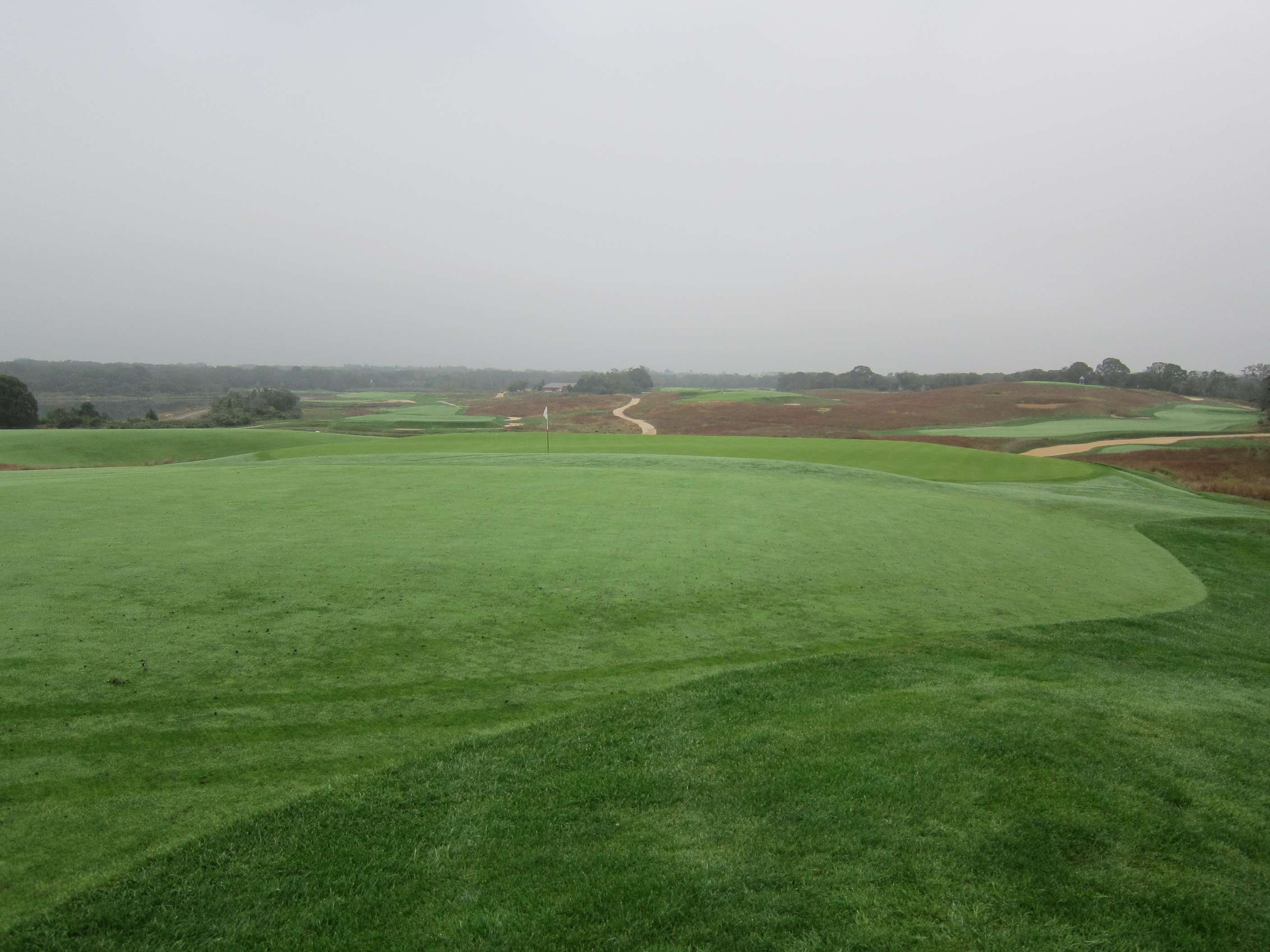 3rd - Alps - 407 yards
3rd - Alps - 407 yardsThe first of the iconic holes. The drive is all about trying to get as far up the right-hand side as possible to reduce the blindness, or so it seemed to me. There was a little flat saucer in the right of the fairway about 270 from the tee (see second pic), leaving about 140 yards in from a level lie (rare in this fairway) -- about as ideal as you could want. About 250 yards off the tee is a little bunker to catch a ball that either doesn't fade or is drawn too strongly, and of course short and left of that is plenty of fairway for even the meekest bail-out. The boldness of the green surprised me, and unfortunately I didn't get a photo that did it justice, so you'll just have to look at the drama that leads to that green and imagine a surface in keeping with that!
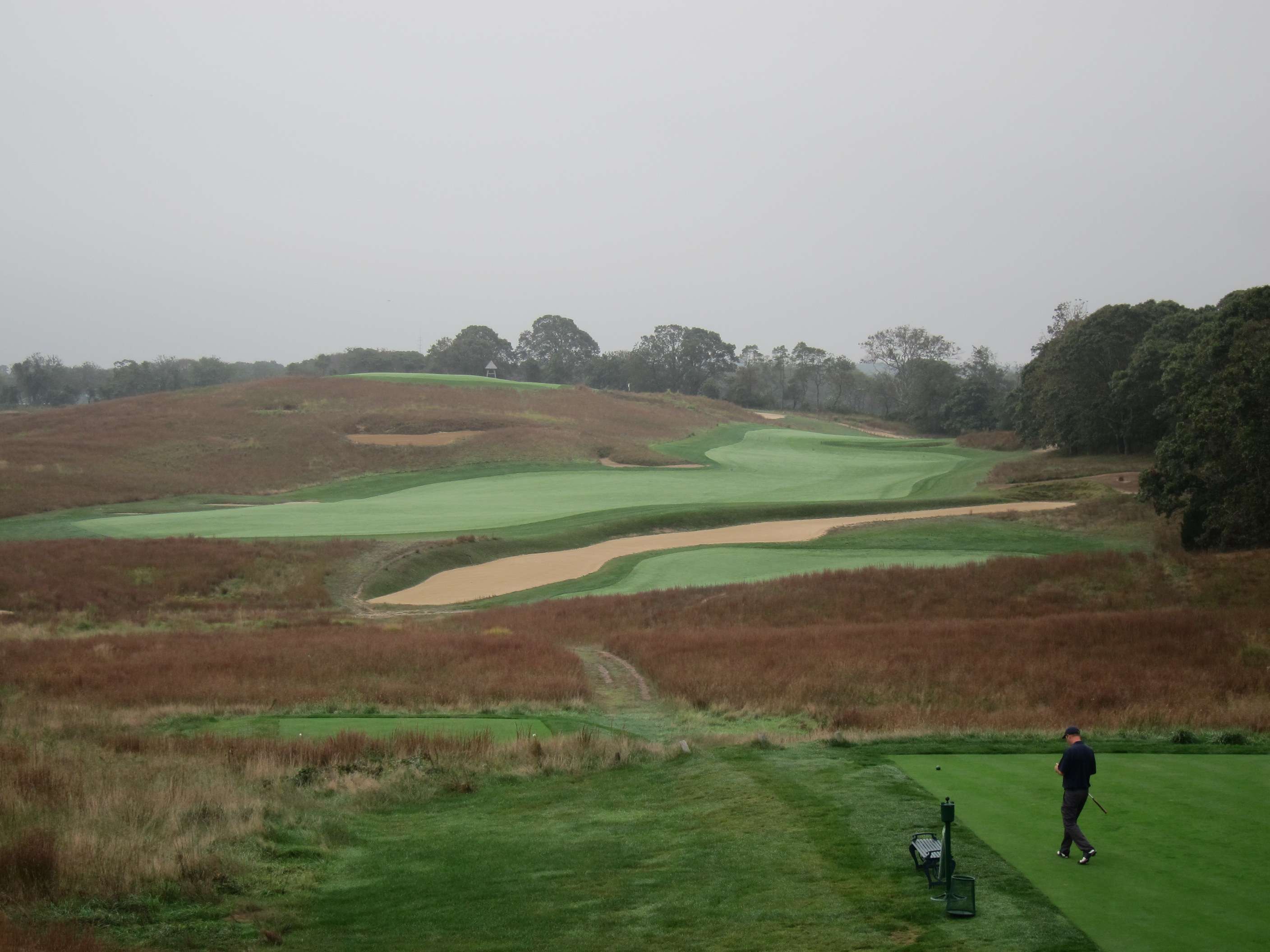

 4th - Redan - 181 yards
4th - Redan - 181 yardsAll the fantastic features of the original Redan hole at North Berwick, with the added feature of seeing your well-executed draw land at the front right and release towards the hole. While pictures of greens rarely convey a true sense of slope, I think the below image shows how the green is the perfect combination of sufficient tilt to do what a Redan should and flat areas to provide pin positions. And to those who categorise MacRaynor design as unnatural, just look how the hole sits on the the hillside as comfortably as you could want. I can understand why this hole is held as the ideal Redan.
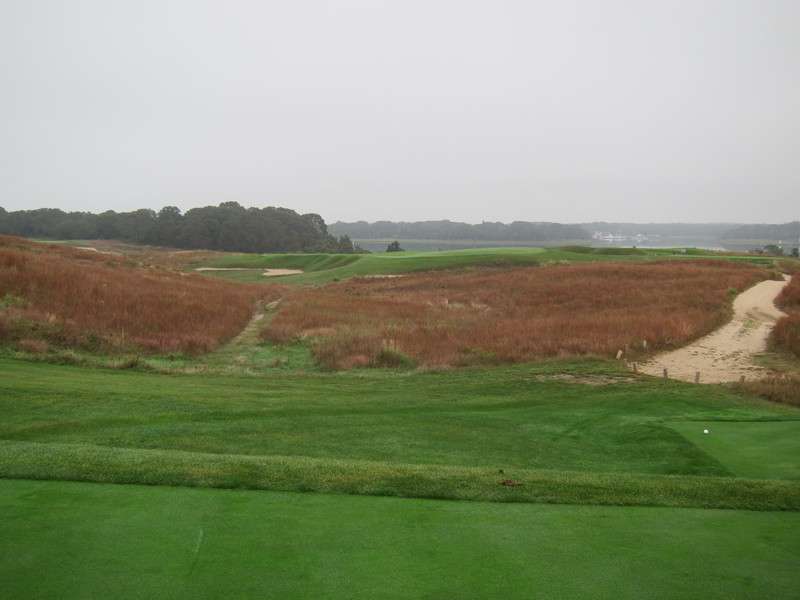
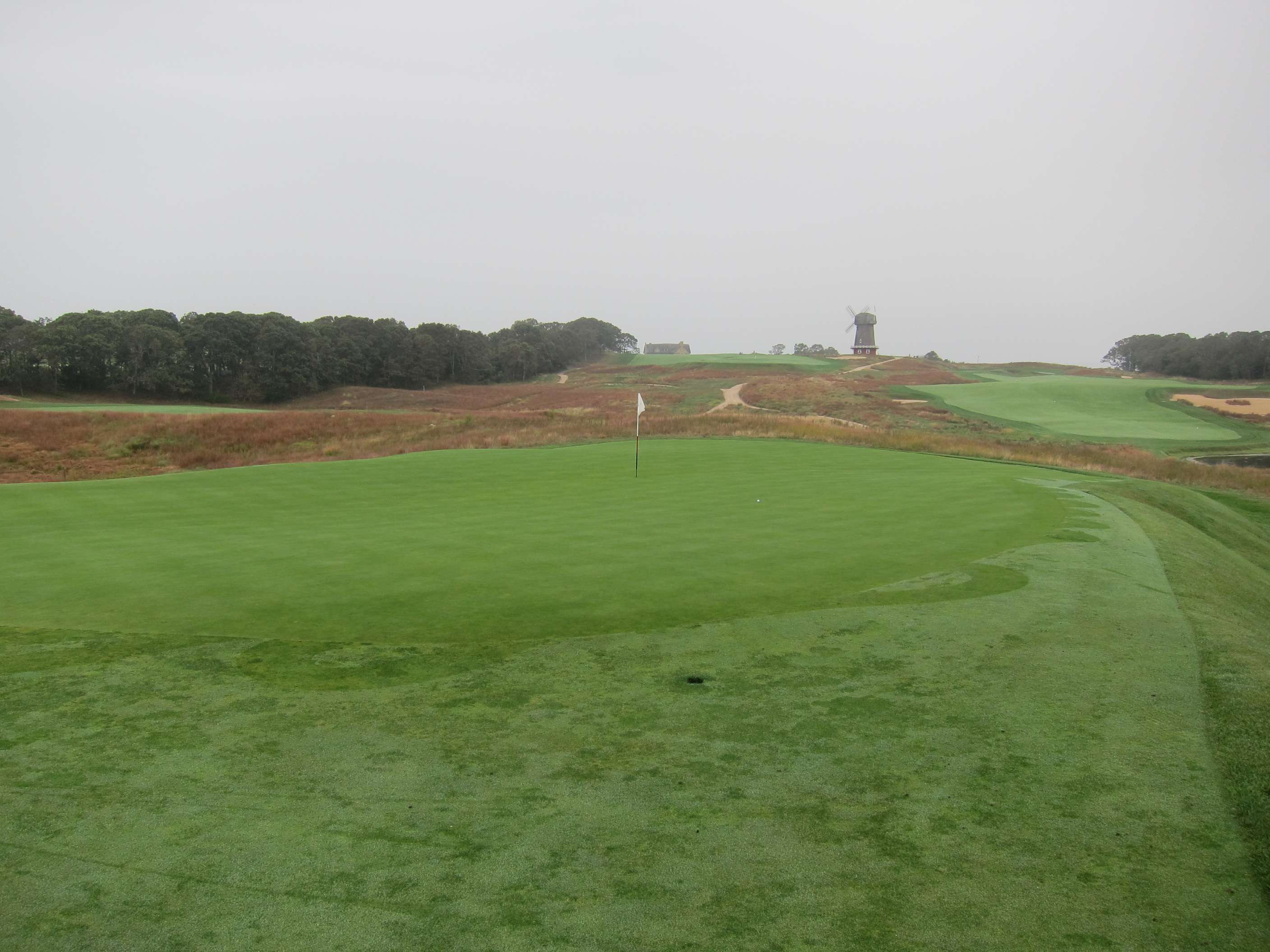 5th - Hog's Back - 451 yards
5th - Hog's Back - 451 yardsFormerly a par five, this hole is now considered a two-shotter on the scorecard. Having avoided the central trench bunker off the tee, your long approach has every chance of running onto the green, which feeds nicely with an open front and right-hand (high) side. For me, the lion's share of the challenge is in picking and committing to the right line on the blind tee shot, with the braver line left of the bunker to a narrower finger of fairway improving the angle to the green.
 6th - Short - 123 yards
6th - Short - 123 yardsShort has one of the most interesting greens on the course, with front right, front left and rear segments connected by a central bowl, where you see the pin cut below. With a wedge in hand, the demand is for precise execution. The green edges feed into bunkers in several areas, reducing the actual green area to aim at. The wind is also likely to be a factor, blowing across as you play down from the elevated tee. A great example of challenge being created without reliance on length and without stopping a golfer earning a birdie with strong play.

 7th - St. Andrews - 467 yards
7th - St. Andrews - 467 yardsOne thing the best courses I have played -- Royal Melbourne, Pine Valley, NGLA -- have in common is great tee shot interest courtesy of diagonal hazards that offer incremental reward for the golfer who knows his limitations, but is willing to demand all of his ability -- or savvy enough to shape a drive that turns along the length of the hazard to steal precious extra distance. They also have wonderful greens that combine artfully with tee shot strategy. Nowhere is that combination more successfully achieved than on this hole, with a natural rise providing the blindness created by the tram sheds on the original Road hole, with bunkers and tall fescue replacing the out of bounds on the 17th at The Old Course. The green is a perfect recreation of the Road Hole green's features -- severe front pot bunker, steep rise, dastardly hazard at the back of the green (a 10ft-deep bunker in this case) to demand that even if your brave drive down the right brings you in range of the green, you need to be absolutely precise to be putting for eagle. It's an ideal "par 4.5" hole with modern technology.
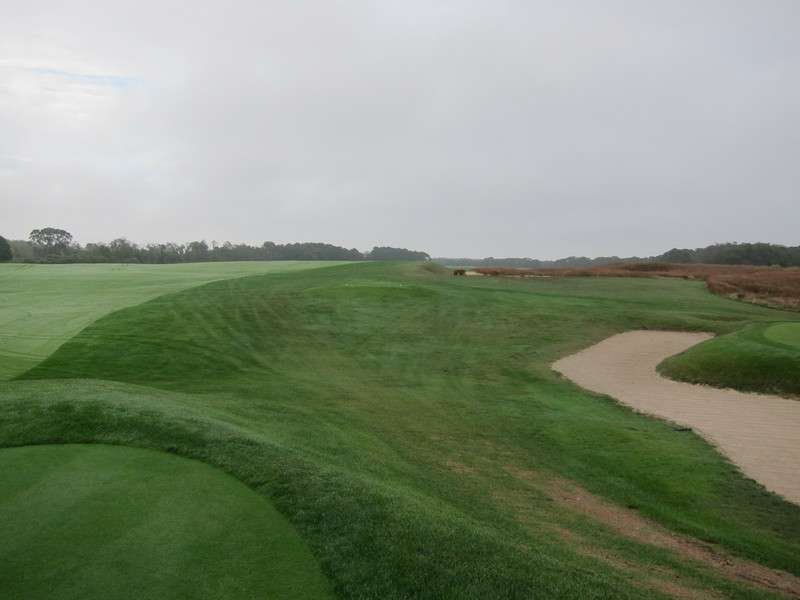
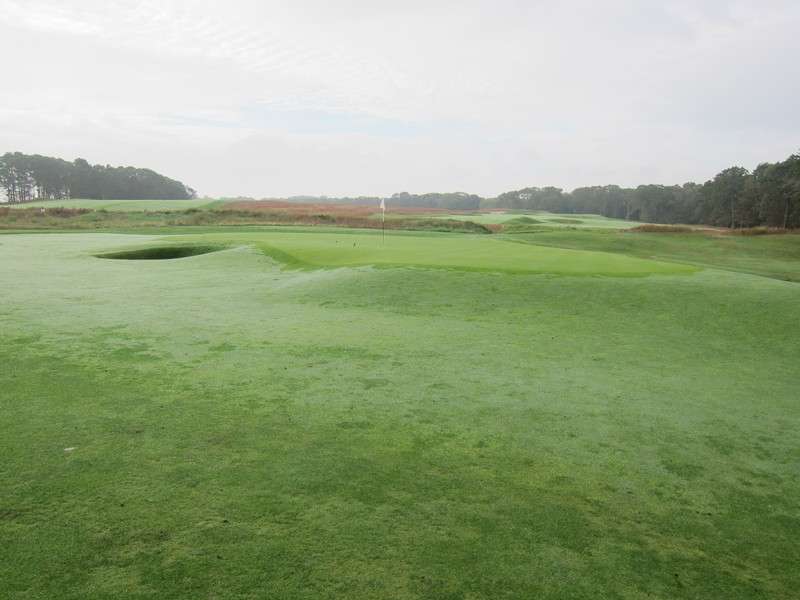 8th - Bottle - 385 yards
8th - Bottle - 385 yardsDo you thread your tee shot down the tree line on the right and come in from an angle? Do you take on the diagonal bunkers entering from the left for a flatter approach to the green? Do you split the difference and cosy up next to the central hazards? It seems to me that this is as much of a "pick your poison" tee shot as you can get and the daily conditions will contribute to your decision as much as what's on the ground. The approach is pure fear, playing over the deep front cross-bunkers to a green with a gigantic false front that is all you can see of the putting surface from even 80 yards short. With the slight uphill nature of the hole it's likely you'll have a mid iron at least for what appeared to me as one of the two or three most fearsome shots on the entire course, though putting is generally easier than elsewhere on the course once you've found the green. On a hole many will fail to reach in regulation, I also enjoyed the downslope from 60 yards and in that creates an awkward half-wedge and rewards the player who lays up smartly further back.
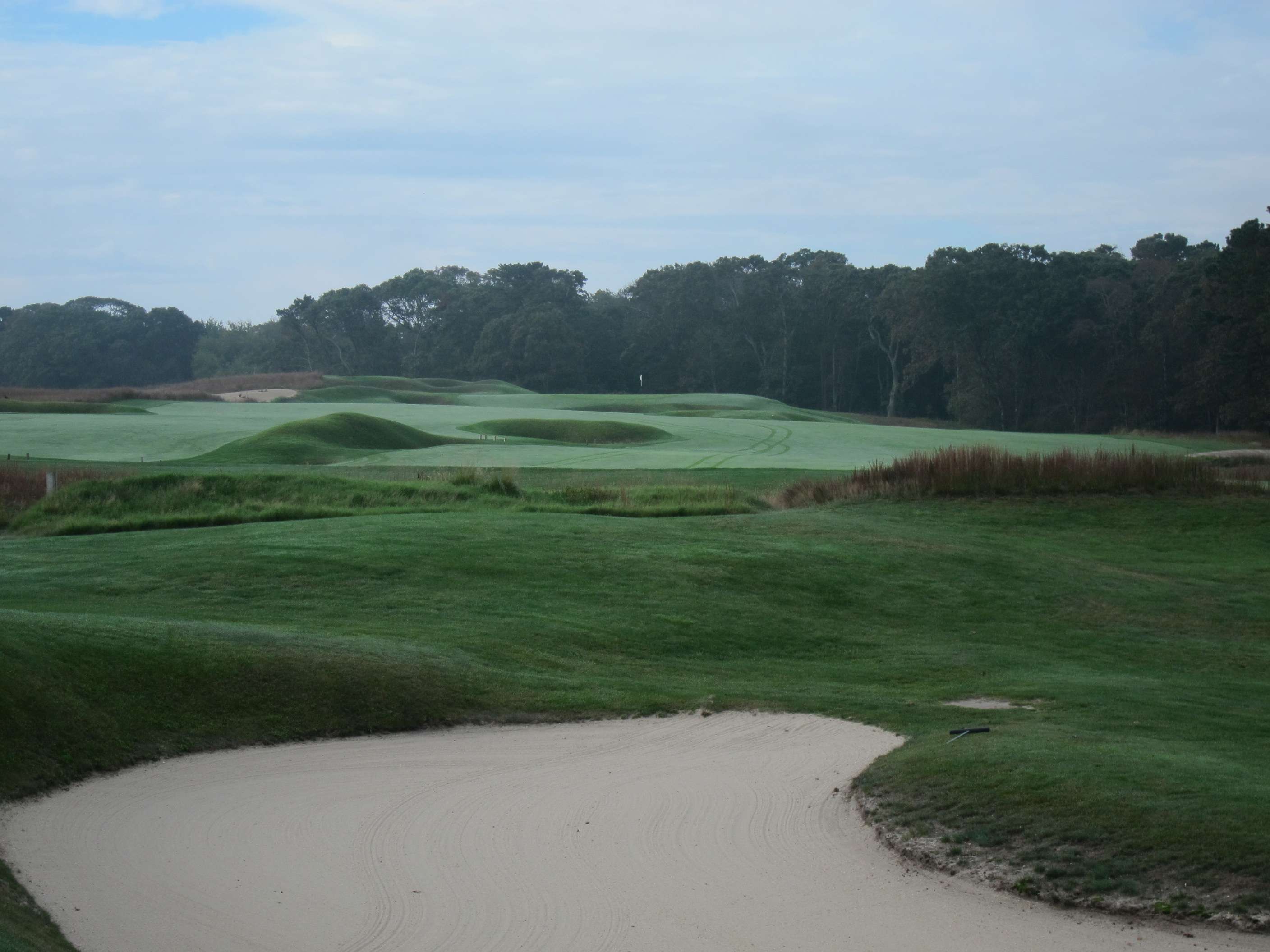
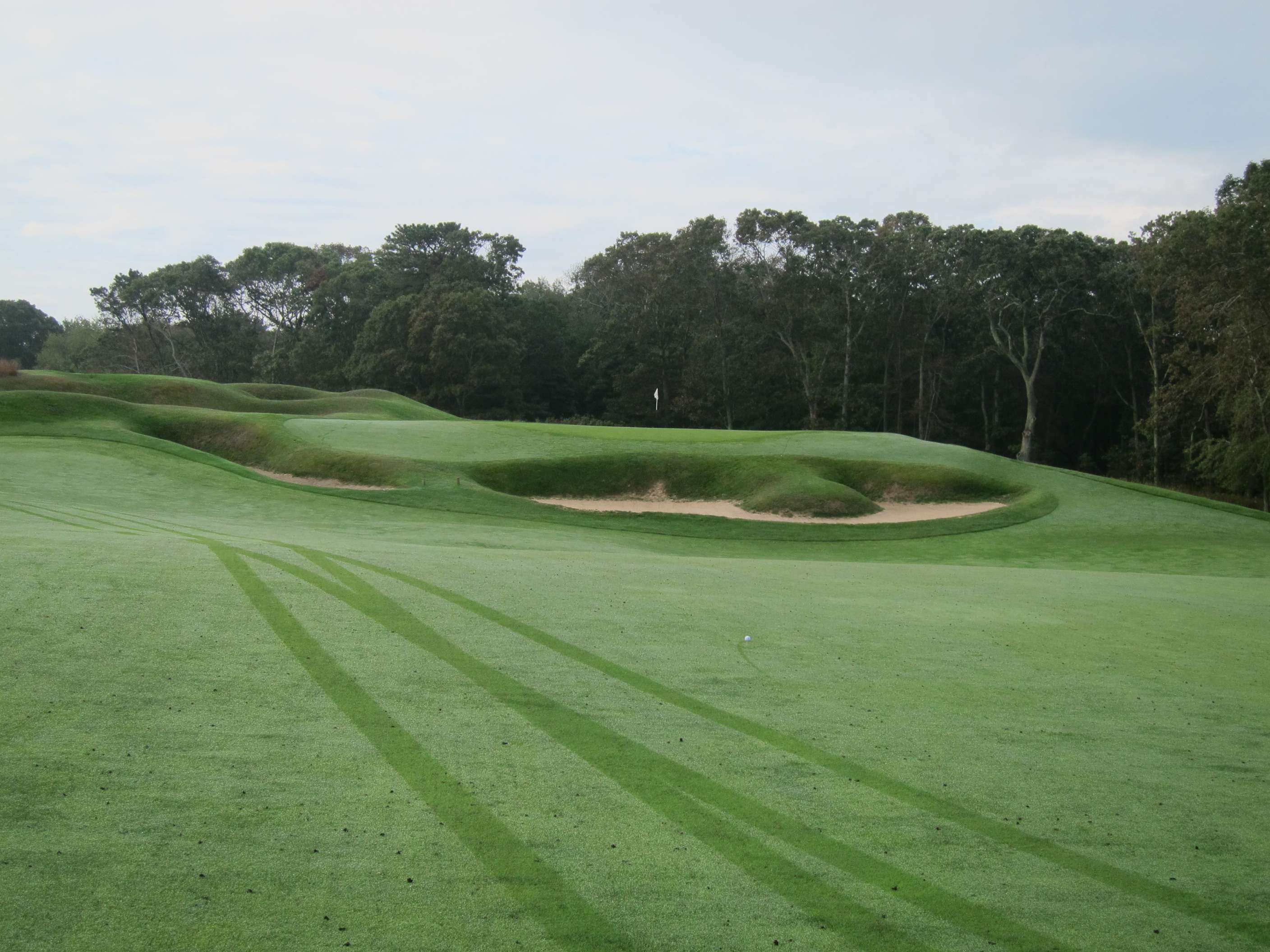 9th - Long - 534 yards
9th - Long - 534 yardsAnother great question off the tee courtesy of the diagonal bunker that allows the player who drives down the right to avoid having to fly "Hell" bunker on the second shot. Though technology allows us to get past that deep expanse of sand more easily than in years gone by, it is still a hazard best bypassed. From the elevated tee you also see the varity of bunker styles employed at National: the deep, narrow trench bunker to carry; steep-faced expanse of sand on the left and, cutting off the fairway up the right, grade-level areas of exposed sand. All three are used well throughout the course. The approach is one of the easier wedges on the course provided your first two strikes were true, though as the sedate green slopes slightly away from you, distance control becomes tricky to a back pin.
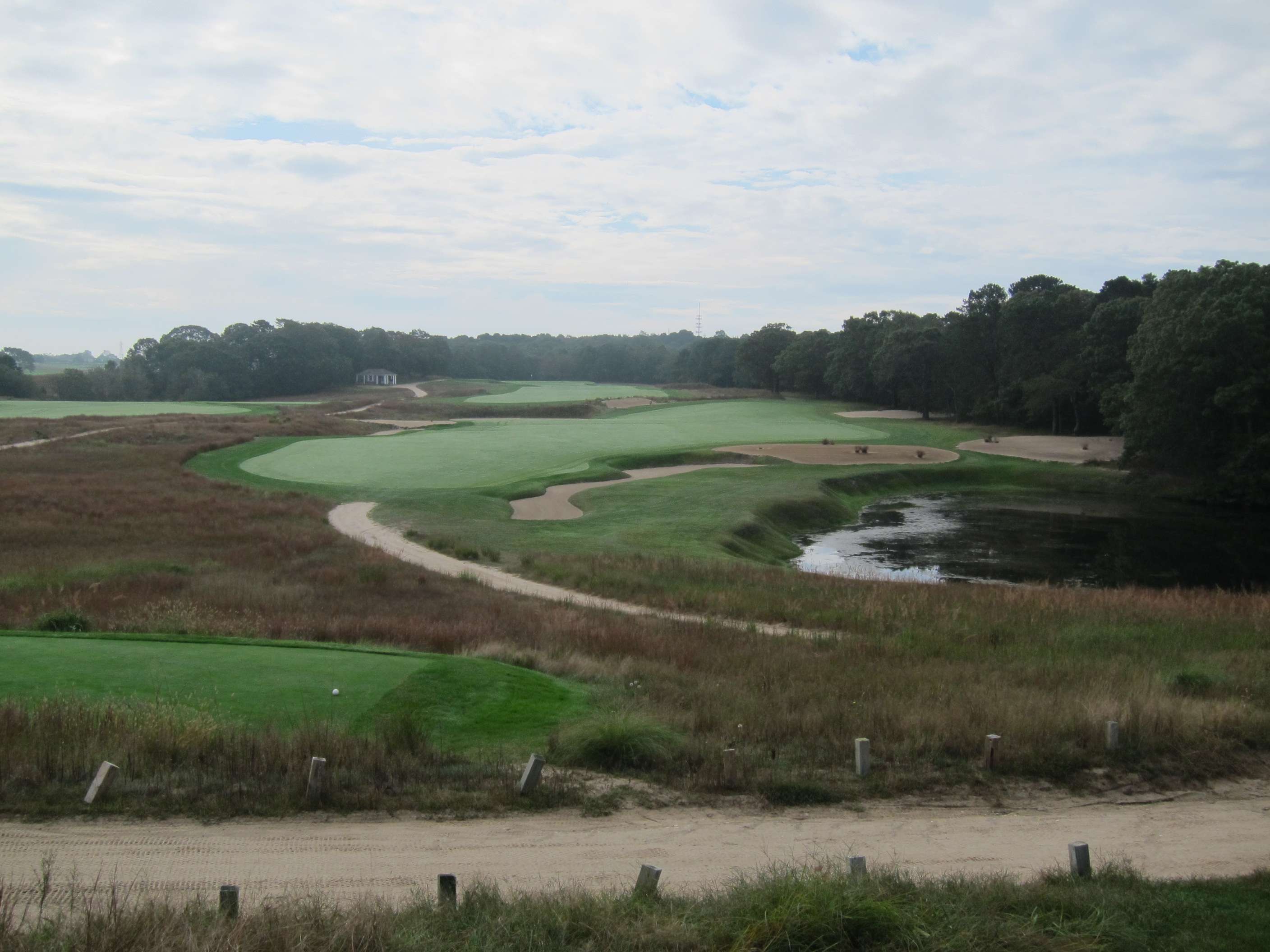
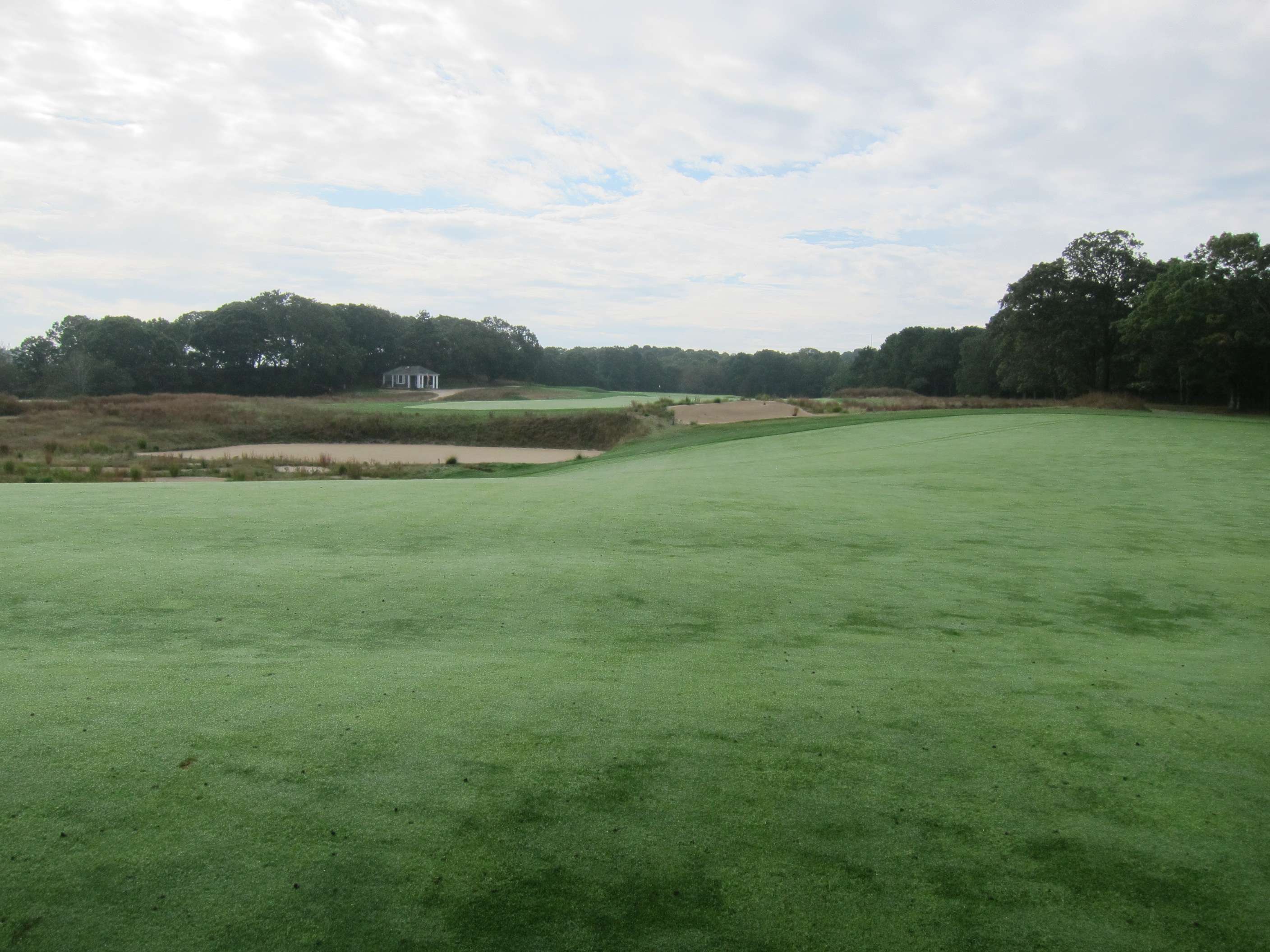 10th - Shinnecock - 420 yards
10th - Shinnecock - 420 yardsAnd so, having snaked to the far reaches of the property with changes in direction after the 1st, 3rd, 4th, 5th, 6th and 8th, we turn for home and find the hole's namesake course through a narrow grove of trees to the right. The drive is to a wide fairway with a carry bunker easily flown to set up an approach to an enormous two-tiered green, its high back platform occupying perhaps just 20 per cent of the surface and that epic front portion blind from many points in the fairway. We are on the flatter land of the course from here until the 12th and to hold the golfer's interest, Macdonald built three of the most fascinating greens on the course. Making that small back section easier to hold, there is a steep backboard that keeps balls from running long if they are struck slightly too hard.
 11th - Plateau - 418 yards
11th - Plateau - 418 yardsA brilliant Double Plateau green here on a flat piece of land, obviously built by man, but when it creates such interesting shots you'd be a hard marker to complain. Adding to the approach shot interest is that the target will be blocked by the mounds that protect the road crossing the fairway (which you also hit across with your drive at the 8th). The entire near side of the green is free of bunkers, so you can choose an approach -- aerial or running -- to suit the distance, pin and daily conditions.
 12th - Sebonac - 427 yards
12th - Sebonac - 427 yardsThe final hole in the trio of lengthy two-shotters that begins the back nine asks for a drive over a gentle slope with a greater kick forward provided to balls that flirt with the bunkers up the left. The green is domed, with a ferocious deep bunker long and a false front short, while the golfer's approach view is unbroken until the far side of Bullhead Bay, making depth perception tricky. Like the 5th, 8th and 15th greens, there is little internal contour, but the steady slope ensures anything left above the hole will be far from a comfortable two-putt. False fronts feature on a good number of holes on the course, perhaps best at the 8th, here and the 15th -- in all three cases you feel you have far less target area than you do in reality.
 13th - Eden - 159 yards
13th - Eden - 159 yardsA fantastic recreation of the original hole at TOC -- a steep green, well-placed Hill and Strath bunkers, a deep trench bunker behind the green substituting for the Eden estuary and ample space on the right to cut the pin behind Strath. You can even see Shell bunker just over the maintenance road. As with the other two par threes at National, this hole turns perpendicular to the general out and back direction and plays in a prevailing crosswind. The back bunker wraps right around the right-hand side of the green.
 14th - Cape - 341 yards
14th - Cape - 341 yardsThe major challenge here lies in choosing a line off the tee that is neither too far left, where it will find leavy rough, nor too far right, where water lurks along with sand. The fairway is the most "linksy" on the course, almost certainly making for an uneven lie and/or stance on the delicate approach. The built-up green juts out into the hazard that wraps around its right-hand side, but an open front allows for a running approach, something thankfully provided for by the conditioning.

 15th - Narrows - 368 yards
15th - Narrows - 368 yardsThe name doesn't lie. After playing to generous fairways for most of the round, this one -- still not narrow by modern standards -- feels like a single carriageway and the severity of the green means you're keen to cover every possible yard of the journey on the tee shot. The green looks like it is 90% false front, though in reality there is more room up top than it seems. But playing on your mind is a 10ft-deep bunker at the back, with the green sloping away from it -- a shot you don't ever want to leave yourself. The result is a shot like those at the 8th and 12th where both long and short are bad results and you're just trying to gentle one to any part of the green that will hold the ball.

 16th - Punchbowl - 394 yards
16th - Punchbowl - 394 yardsA chance to open the shoulders, though accuracy is paramount if you want to tread the tightrope of the high ground in the centre of the fairway that separates deep bowls both left and right. The greensite, set down low over a dune as the name suggests, is subtle and understated and with the windmill set above it on the hillside it might be one of the most idyllic spots on the entire course. Of course it also provides that great thrill of hitting a solid approach and then cresting the dune in front of the green minutes later to find out where your ball settled. A great example of Macdonald (and Raynor) using the natural movement of the land in siting their templates.


 17th - Peconic - 342 yards
17th - Peconic - 342 yardsFrom a high tee with an expansive view over the bay, you have to decide whether you can carry the partially-obscured trench that runs down the left at a diagonal, or if you're going to veer right and navigate over or between the central bunkers in the fairway. Either flank will afford you a view of the green, but by splitting the difference you're left behind a dune of exposed sand with just the top of the flagstick in view. With the deep bunker that sits behind the green, it's really a shot -- although only a wedge or even a pitch -- that you'd like to undertake with a clear view of the target. And with no shelter from whichever wind is blowing, your tee shot line is as dependent on the day's conditions as any shot on the course.


 18th - Home - 483 yards
18th - Home - 483 yardsThe drive is exciting, with two cavernous bunkers on the left and a steep drop on the right-hand bay side of the fairway, leaving an uphill, blind second to an area that is wide, but dotted with sand -- though it is more visible if you have successfully challenged the bunkers off the tee. The green provides a stern test for your final full shot of the day, running to a cliff on the right and far deeper than it might seem. To make the back pins even tougher, the green narrows at its rear and a miss to the "safe" left-hand side is no picnic either. This and the penultimate hole pair well with the opening two to create a start and finish that play far tougher than the card distance indicates.

